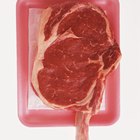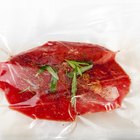Foodborne illnesses are commonly associated with raw meats that sit out for longer than they should. Meat provides the ideal environment for bacteria to breed, so the U.S. Department of Agriculture cautions consumers against thawing raw meat at room temperature. In fact, raw meat should never sit out in temperatures above 40 F for extended periods of time – and never longer than two hours for any reason.
The Two-Hour Rule
The type of meat doesn't matter when it comes to the two-hour rule. If it’s raw, it’s no longer safe to eat once it sits out at room temperature for two hours. Once you've reached the two-hour time limit, bacteria that is naturally found on raw meat begins to grow to levels that are unsafe for consumption. Do not refrigerate or cook meat that sits out for more than two hours; throw it away.
Refrigeration
Don’t allow raw meat to sit out after you buy it. Instead, refrigerate raw meat immediately after purchasing it from the supermarket or butcher. Although refrigeration does not destroy bacteria on raw meat, the 40 F or less temperatures inside the refrigerator do inhibit their growth. Bring a cooler filled with ice to store your meat if you are not going straight home. The icy temperatures of the cooler keep raw meat safe from excess bacterial growth until you can get it to the refrigerator.
Freezing
Popping a package of raw beef, lamb, pork or veal in the refrigerator after purchase gives you about three to five days of storage time before cooking is necessary; poultry and ground meats last a little less in the fridge – up to two days. The same raw meats last for an indefinite amount of time in the freezer, often up to a year before taste and texture begins to change. Although the changes are not a safety issue, they may affect the intended taste of the dishes you prepare.
Safer Thawing
There are a few ways that you can safely thaw frozen meats. The easiest is to take raw meat out of the freezer the night before to give it plenty of time to thaw in the refrigerator. Last-minute thawing is best done in an airtight, watertight package placed inside a bowl of cold water in the sink. Change the cold water every half hour until the raw meat thaws. Microwave thawing is also safe. Just make sure that you cook the meat immediately after microwave or cold-water thawing, because once the raw meat reaches 40 F, bacteria will begin to grow rapidly.
Related Articles

How Long Can Meat Stay out of the ...

How to Keep Lunch Meat

How Long Does It Take for Ground Beef ...
Can You Freeze Shish Kabobs?

What Does It Mean When Hamburger Smells ...

How Long Do Clams Last Unrefrigerated?

Can You Cook Meat Gone Bad?

Should I Cook My Turkey if It Is Smelly?

Rules for Thawing and Refreezing Meat

Indications of Refrigerated Cooked Meat ...

Do You Thaw Hamburger Patties Before ...

FDA Food Storage Temperature Guidelines

How to Keep Thawed Liver Before Cooking ...
Can You Use Stew Meat That Has Been ...

If Meat Is Frozen, How Long Does It ...

Is Frozen Ground Beef Left out for 3 ...

How to Store Cooked Ground Beef

How to Know When Pork Roast Goes Bad

How Long Do You Keep Meat in Freezer?

Should You Cook Raw Meat That's Gone ...
References
Writer Bio
Jonae Fredericks started writing in 2007. She also has a background as a licensed cosmetologist and certified skin-care specialist. Jonae Fredericks is a certified paraeducator, presently working in the public education system.